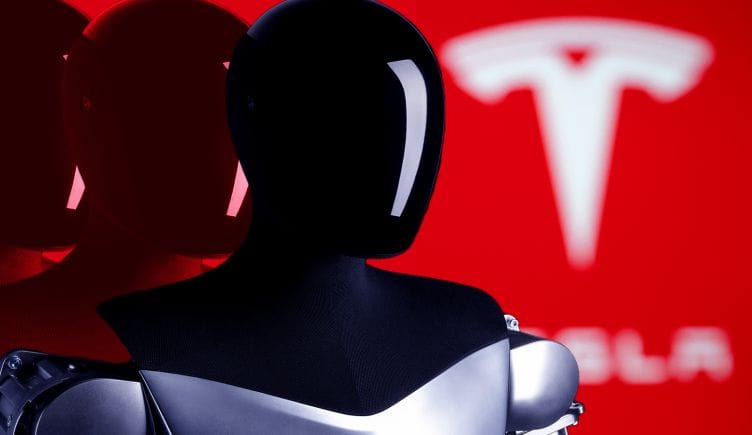When Elon Musk first announced Tesla’s splash into robotics by introducing a dancer dressed in a bodysuit, the Tesla robot may have seemed like a far-fetched idea. Fast-forward to the present, and Tesla’s robot Optimus is on the verge of becoming a viable product.
What Is the Tesla Robot?
Known as Optimus, the Tesla robot is a humanoid robot designed by Tesla. The company’s CEO Elon Musk introduced the concept in 2021, and the first prototype was unveiled at the company’s 2022 AI Day. Musk hopes to one day produce the robot on a mass scale.
There’s still much speculation surrounding the exact details of this humanoid robot, but Musk and his team have dropped plenty of clues about when Optimus could become available and what roles it could play in the years ahead.
What Is the Tesla Robot?
The Tesla Optimus robot is a humanoid robot that can walk on two legs and engage with the physical world with a pair of arms and hands. Tesla has compared Optimus to the company’s cars, saying the company has simply transitioned from making robots on wheels to robots with legs. It’s no surprise, then, that Optimus adopts much of the technology seen in Tesla vehicles, including an AI system to understand and map out its surroundings.
Following Musk’s 2021 announcement of the Tesla robot, a prototype was released in 2022, and the next version known as Optimus Gen 2 was revealed in December of 2023. During Tesla’s 2022 AI Day, Musk touted Optimus as “a fundamental transformation for civilization” and a contributor to a “future of abundance” — one without poverty and “where you can have whatever you want in terms of products and services.”
Musk believes Optimus will one day help millions of people and potentially boost economic output by “two orders of magnitude.”
What Can the Tesla Robot Do?
Optimus is able to walk forward, self-calibrate its limbs and move them in various directions as well as place its body into different poses (including one where it balances its body using one leg). It can also pick up, sort and make corrective adjustments to hand-held objects — like placing a fallen toy block rightside up — all on its own. Additionally, it can recognize environments it encounters and locate its own limbs within its field of view.
What Can Tesla’s Optimus Do?
- Walk forward
- Squat down
- Sort objects based on color
- Balance on one leg
- Lift an object with one arm
- Squeeze an object and lift it
Optimus Gen 2 is light-years ahead of the early version that debuted in 2022.
“The hand design was quite basic,” Alexander Kernbaum, interim director of SRI International’s Robotics Laboratory, a research institute that developed the humanoid robot Proxi, said of that 2022 model. “And I would say the majority of time spent should be on the hand and dexterous manipulation.”
And when it comes to movement, Carlotta Berry, a professor of electrical and computer engineering at Rose-Hulman Institute of Technology in Indiana, found the prototypes to be unimpressive compared to other humanoid robots like Boston Dynamics’ Atlas, which can do parkour.
Berry, whose research interests include human-robot interaction, told Built In she would expect Optimus to use some natural language processing so the robot would be able to work together with humans and understand their intent without verbal cues.
What Will the Tesla Robot Be Used for?
It’s not clear what Optimus is intended for, mainly because Musk himself hasn’t expressed a concrete vision for the robot in the past. Given Optimus’ ability to deadlift 150 pounds and carry 45 pounds while walking at 5 miles per hour, it makes sense to use the robots in factory settings. In fact, Musk has suggested Optimus robots could address labor shortages, and he even intends to introduce the robot in Tesla factories.
How Does the Tesla Robot Work?
Optimus has its own ‘brain’ or central computer, powered by an AI chip containing a trained neural network. The robot also relies on AI technologies like deep learning and computer vision alongside autopilot cameras and sensors to perceive and navigate its surroundings, as hinted at by the open positions on Tesla’s careers page.
Optimus also has a visual navigation system managed by fully trained, end-to-end neural networks to get around. It’s loaded with a library of natural motion references — essentially, engineers recorded human motions, like grabbing a box off a shelf, and mapped that motion data, which has been optimized to adapt to real-world motion, to Optimus. And because the Tesla robot uses the same AI system as the company’s vehicles, it can remember environments to improve future interactions.
For its outer shell, Optimus is designed with a combination of metal and plastic, although plastic is emphasized to make the body more lightweight and efficient. The robot also features an interactive screen on its face for displaying and communicating information. To perform actions, Tesla’s robot guides its movements with a self-driving computer located in its chest and is sustained by a 2.3 kilowatt-per-hour battery.
When Will the Tesla Robot Be Ready for Use?
The timeline for when Tesla robots will be released varies. Optimus robots could start shipping as early as 2025, although some estimates don’t anticipate the robot going on sale until 2027. Still, there’s no guarantee a finalized Tesla robot will be ready by then due to questions regarding its relevance.
While many of the tasks Optimus is slated to perform may be helpful, Kernbaum pointed out that robots already exist with the Tesla robot’s proposed capabilities, albeit separately.
“Optimus is pitched as a general-purpose robot, and I think we are very far away from a time when that will make sense,” Kernbaum said. “Possibly not in my lifetime.”
Technology limitations are one reason behind the delay, according to Kernbaum. But a lack of demand is another, he said, especially when it’s easier to develop a robot that’s really good at performing one task, like picking strawberries, or to change a factory or logistics facility around to meet the needs of the robot.
How Much Will the Tesla Robot Cost?
During the 2022 AI Day event, Musk said that the Tesla robot will cost $20,000, more or less. He has since said that, while “complexity per unit mass is much higher with humanoid robots,” he still thinks the price will eventually be “less than half of a car.”
Frequently Asked Questions
How much will the Tesla robot cost?
It’s still too early to determine the exact price of a Tesla robot, but Musk has estimated it could cost less than half of a Tesla car. This would place Optimus at around $20,000.
What is the Tesla robot supposed to do?
Musk didn’t design Optimus with a clear vision in mind. However, he’s recently proposed the Tesla robot could help address labor shortages and work in factory settings.
Did a Tesla robot attack a worker?
In 2021, an engineer at a Tesla factory in Austin, Texas, was performing maintenance on three robotic arms, but didn’t realize one of the arms was left on. The arm began moving and pinned the engineer, clawing his back and arm in the process. Another worker hit an emergency stop button to shut off the robotic arm before the incident turned more serious.


